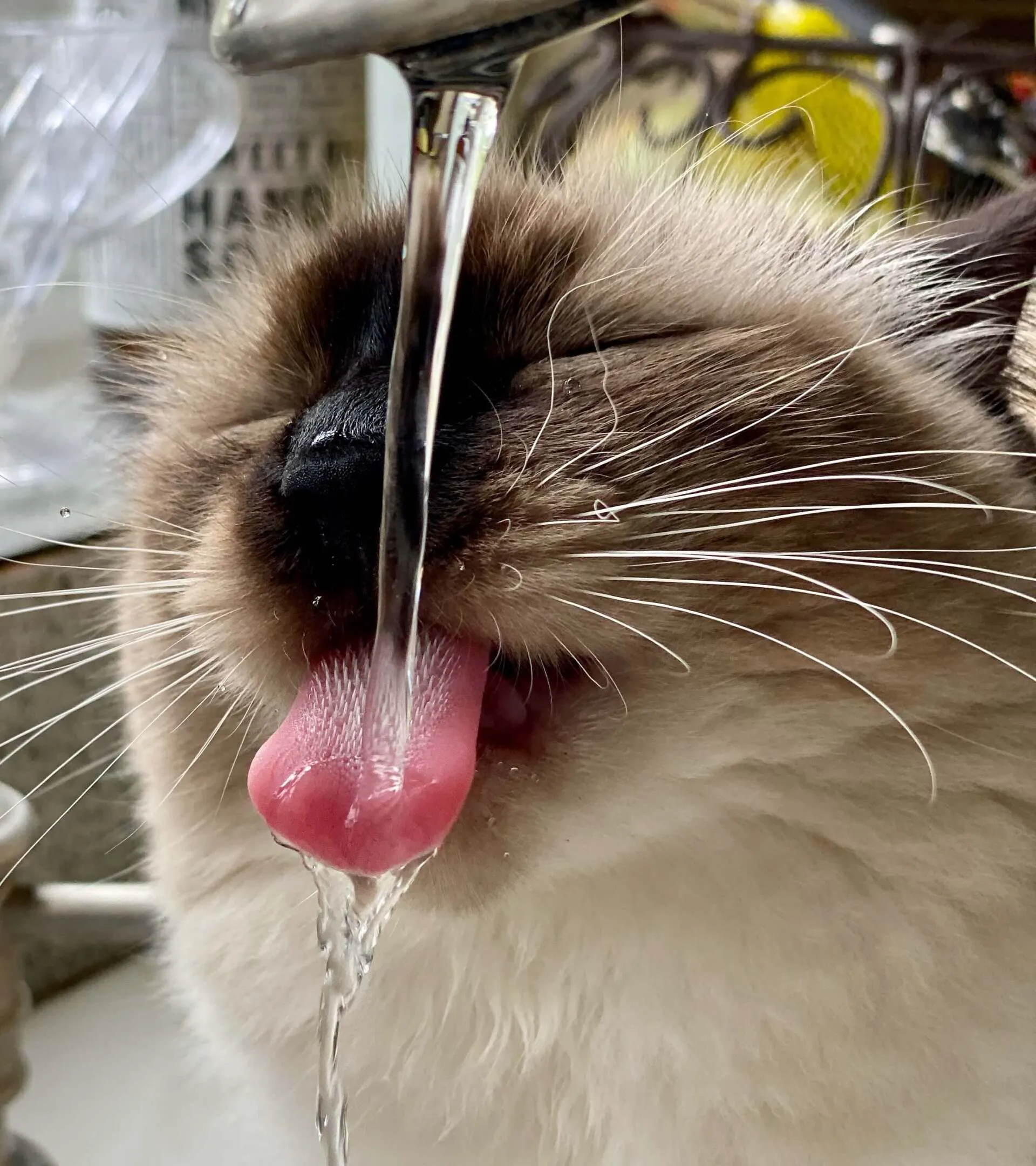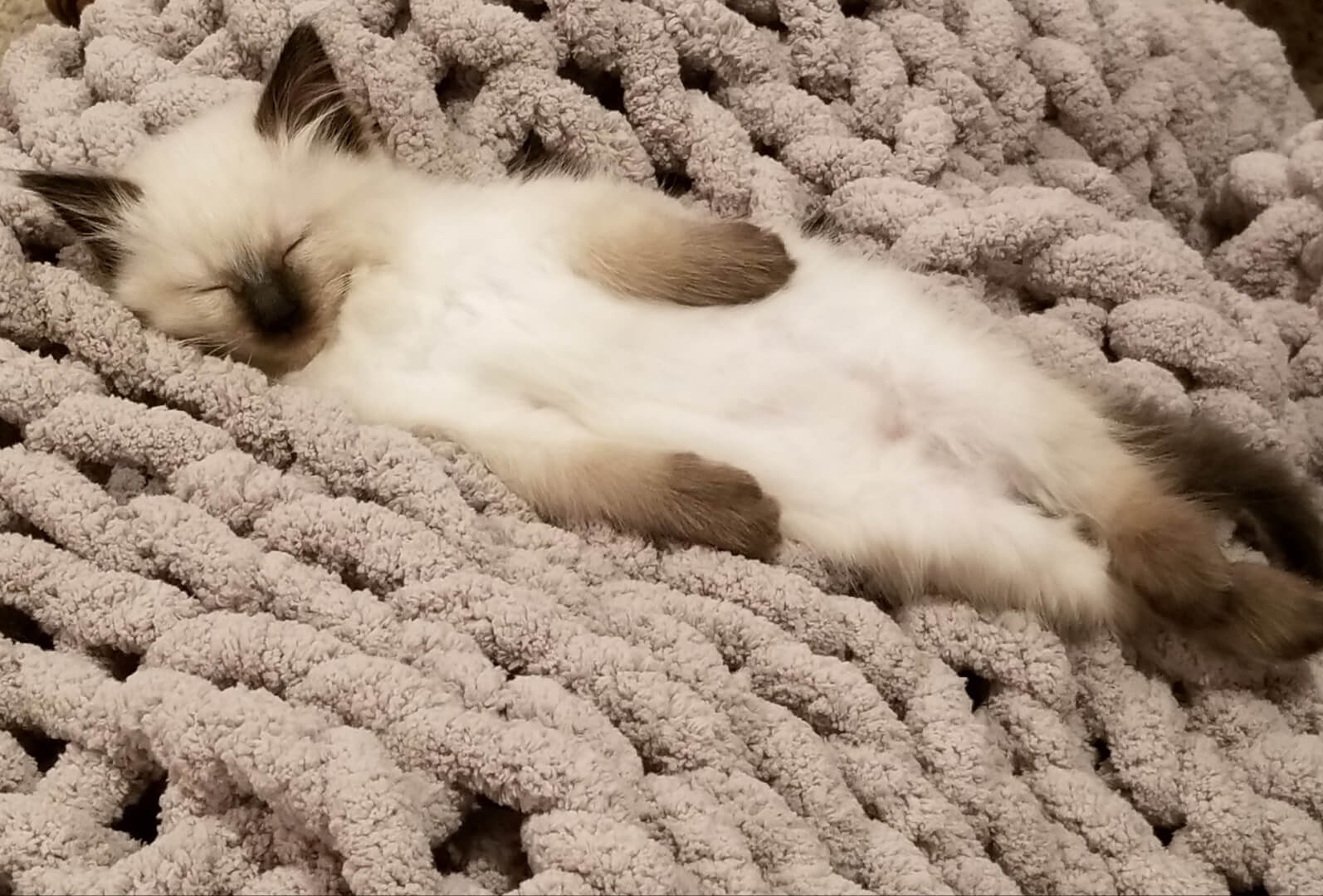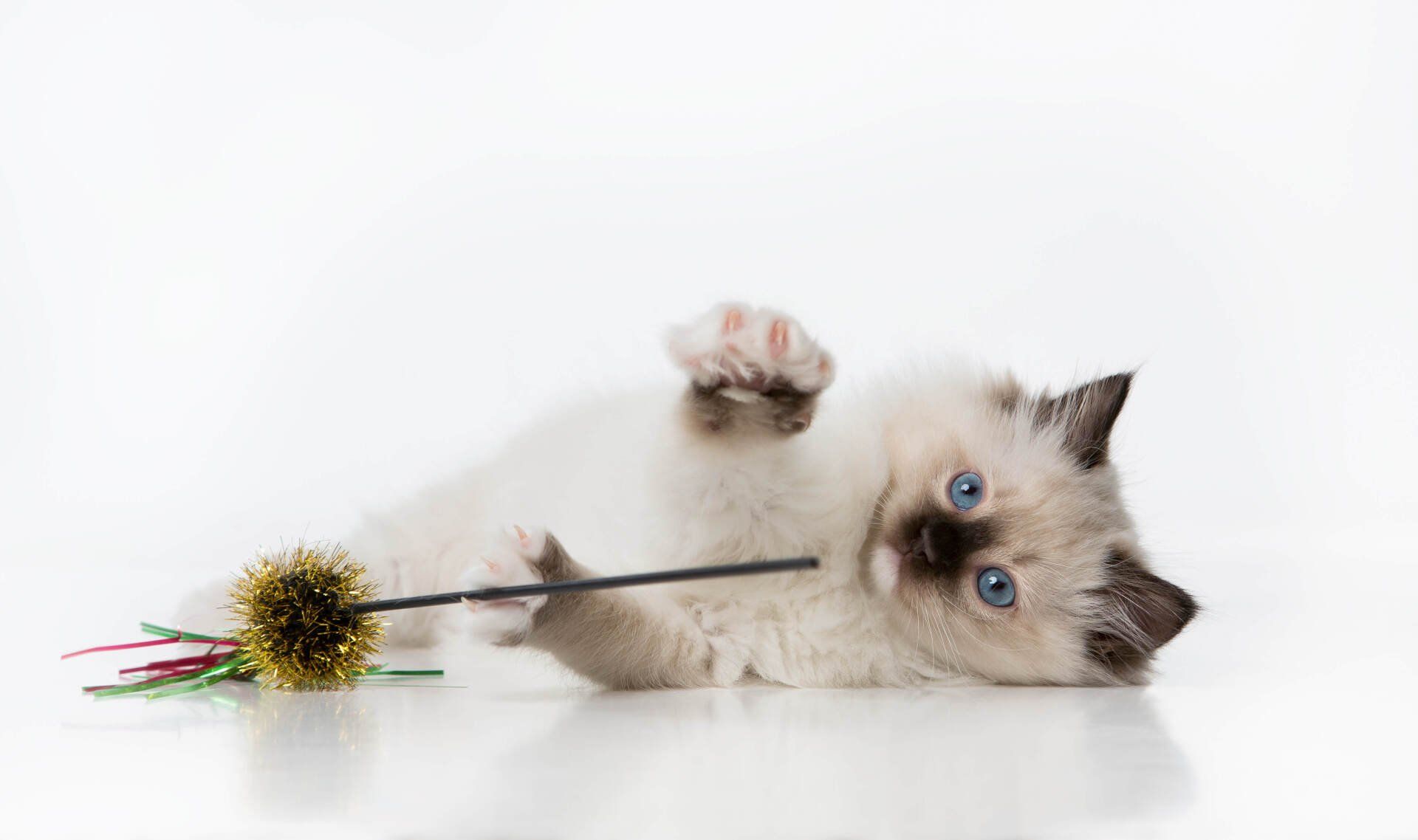Bath Time
Bathing Your Ragdoll Kitten with the Utmost Care
Possible Supplies Needed: Hypoallergenic and unscented shampoo (or baby shampoo), pure Epsom salt (no additives), nail clippers, comb or brush, gentle pet wet wipes, two small containers, soft washcloths and/or towels
If you’ve ever seen the humorous internet instructions from the dog on "how to bathe a cat" or googled cat bathing as a martial art, then you know bath time is not a preferred activity for the preservation of your cat’s self-dignity (and even your relationship if you were to overly bathe them). Cats are known for their grooming habits and have been referred to as "little baby car washes" by one cat behaviorist. Using their tongues, teeth, and paws, combined with special enzymes/proteins in their saliva, they are usually able to keep themselves fresh and clean without any outside intervention. On occasion, there will be good reason to bathe your cat (such as for the removal of a smell or other foreign material stuck in their coat). You may prefer to leave this detail to the professionals at the local groomer or vet as they are experienced with cat bathing.
With regards to your cat's overall hygiene, it IS important to regularly brush their coat, trim their nails (please seek expert guidance before doing this), provide fresh food and water, and to clean their litter box on a daily basis. From the time they are little, it is important to regularly scan your kitten's coat for any debris (especially around their bottoms). Kittens can be a little more compliant than cats, so gently brushing and spot cleaning them while they are sleepy can be something they learn to really enjoy moving into adulthood.
Brushing Your Cat
Ragdolls do not have an undercoat, but they can still develop mats, so gently brushing them on a regular basis will help maintain their beautiful coat. Begin brushing your kitten when they are young and always when they are in a restful, cuddly state. Grooming time can be another form of praise for your kitty, as most connect this to cleaning time with their mama. It is also a great way to regularly ensure your cat's fur and skin are healthy through regular inspection of their bodies for injuries or mats. Additionally, you are stimulating the sebaceous gland that makes oil for their coats to be shiny. Brushing discourages the formation of dander and prevents them from swallowing too much hair when they groom themselves. Use loving voices and either place them on your lap or sit on the ground with your legs forming a small enclosure around them. You may find that your cat loves to be brushed in certain areas and not so much in other places. For areas that are preferred, let the brush be their reward. For areas they don't like having brushed, allow them to move away and return to you. Reward them with a treat and quickly brush them in that less-preferred area. Remember that the skin of a cat is thin, so be very careful when shaving or cutting off a larger mat that has formed. It is also a good idea to trim their nails. Before doing so, educate yourself on the safest manner to trim nails by asking a vet, reading instructions, and watching videos online.
Spot Bathing Method (Most Desirable)
If your kitten's face needs to be cleaned, use only water and a warm, soft, damp washcloth to clean their face as the eyes and ears are sensitive. For most kittens and cats, the area that typically needs to be spot bathed is their rear ends. Sometimes, the use of a gentle pet wet wipe will do the trick especially as they sleep.
If more cleaning is needed, it typically helps to have an additional person to assist. Before your Ragdoll enters the room (and so they don't hear running water), pre-fill two small containers with some warm water. To the first container, add a small amount of baby shampoo (or the pet shampoo listed above under supplies) and just enough pure Epsom salt that it emulsifies in the water. Fill the second container with warm water. Have two soft washcloths (one for the first container and the other for the second), and always make sure your Ragdoll has something they can stand on with traction (such as a towel). Use the warm, soft cloth and dip it into the baby shampoo/pure Epsom salt mixture to gently clean the kitten and/or area. Always use reassuring voices throughout and repeat the process with a new washcloth dipped in the second container (water only) to rinse. The second person might even feed a lickable cat treat and/or pet the kitten or cat's face during this time to distract them. Our mama cat does not want to be bathed, yet she will purr during this time because it is very calm and she knows we are taking care of her.
When finished, be sure to wrap them in a towel and keep them warm until they dry. Remember that repeatedly rubbing a towel along their bottom can cause chafing, so allow them to dry naturally while keeping them warm (please refer to the "After the Bath" section below).
Full Bathing Method (Least Desirable and Only as Needed)
Trim your cat’s nails a day or so before bathing. On the day of the bath, prepare the bath by finding an area that promotes a quick and easy bathing procedure. This might include a small bathroom sink and a small kitty litter pan converted into a small bathtub. Pre-fill one with lightly soapy water (remember to use unscented, hypoallergenic kitten or baby shampoo combined with pure Epsom salt) and the other with clean water. Both should be filled a few inches high with lukewarm water. Remember that running water might add to the stress of the unfamiliar event, so try to have everything prepared beforehand including a small plastic cup to pour lukewarm water on them as you remove any excess soap. Cats like traction, so it is nice to have an area with some sort of mat or submerged towel at the base. Be prepared to get wet and wear long-sleeved clothing as a protection from your cat’s claws. You will also want to lay out a towel for drying. Choose to bathe your kitten during a time of day when they are more mellow. It is also nice to have a family member assist with bath time. Always speak in calm voices and be prepared to move gently and quickly through the process. Begin by using a warm, damp washcloth for the face with water only as the ears and eyes are sensitive. Dip them in the soapy water and move quickly through the process using a reassuring voice. Quickly move them to the clean water and use a cup as necessary (never over the face) to remove any excess soap. This is important as your cat could ingest the soap as they lick themselves afterward and/or it will attract dirt and debris (another reason why the spot bathing method is preferred when it comes to your feline). Remember that it is never beneficial to be forceful and that you can always spot bathe or leave any necessary bathing to a professional groomer.
After the Bath
Another important aspect of bathing your cat is drying them off afterward. Keep your cat warm by wrapping them in a towel and place them in a warm location until they have completely dried. Depending on their response, you might also prefer to dry them with a hair dryer on the lowest warmth setting to speed up the process. Be sure to keep the blow dryer 18 inches away at all times and move it around frequently. A family member is always a good helper for drying time as well. Once bath time is over, treats, praise, and playtime may help your cat recognize the post-benefits of bath time. Be sure to brush them after they have dried.





